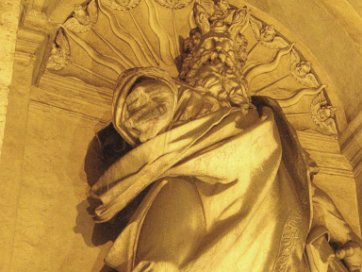
Quattro Fontane
The four fountains are of travertine and represent two rivers and two virtues. They are all by Fontana except that one which is placed across the grille in the wall of the Barberini Gardens. This is the work of Pietro da Cortona. The choice both of the rivers and of the virtues is significant. Pope Sixtus V's early life shows what need he had of fortitude, while fidelity marks his attitude toward his two (and only) friends, Pope Pius V and Domenico Fontana.
The Tiber, represented by a river-god behind whom the reeds are growing, was of course to be expected. The Anio, also a river-god but with the emblem of the oak-tree, may have been chosen because of Sixtus V's intention to bring its waters to Rome, not by an aqueduct but in a canal, for the transportation of the travertine and wood needed in his great enterprises. For the Tiber also he had plans. He wished to enlarge its bed so that he might bring up his galleys from the sea to Rome; and he had a scheme for its separation at the Ponte Molle and for bringing one arm of it behind the Vatican, so as to make an island of that part of Rome containing the papal palace, St. Peter's and the Castle of St. Angelo. These were among the projects which he had not the time to carry out, for Sixtus V's pontificate lasted but five years.
When Pope Sixtus V completed the restoration of the Acqua Felice aqueduct toward the end of the 16th century, Domenico Fontana was…